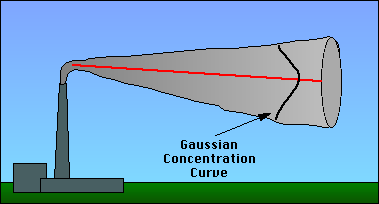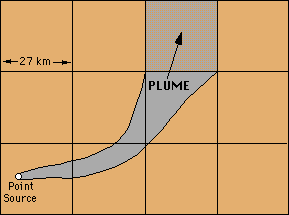Part 5:
Air Quality Models
Air quality models (AQMs) are models which in any way simulate a phenomenon or subject of interest that deals with air quality. Generally, this means modeling particle and gaseous dispersion in the atmosphere. The more advanced AQMs incorporate meteorological model output data into the input data for the AQM. There are several types of air quality models. We will discuss two here: the Gaussian plume and Gaussian puff models and the plume-in-grid model. These two are specific types of air quality models.
 Gaussian Plume and Gaussian Puff models are those which model the dispersion of gases and particles from factories or other point sourcs, area sources, and volume sources. Based on the stability, stack height, and wind profile, the Gaussian dispersion models are used to predict pollution concentration downwind of the source. These models assume that the concentration is dispersed in the vertical and horizontal in a Gaussian, or bell-shaped, manner, with the highest concentrations in the center of the plume.
Gaussian Plume and Gaussian Puff models are those which model the dispersion of gases and particles from factories or other point sourcs, area sources, and volume sources. Based on the stability, stack height, and wind profile, the Gaussian dispersion models are used to predict pollution concentration downwind of the source. These models assume that the concentration is dispersed in the vertical and horizontal in a Gaussian, or bell-shaped, manner, with the highest concentrations in the center of the plume.
You are encouraged to experiment with a real Gaussian Plume Model. We have developed a model interface that will run a model on a remote computer and then return to you a graph displaying the model results. Visit the Gaussian Plume Model page
Plume-in-Grid Model
A plume model (such as the Gaussian plume model) is good for tracking air parcels downwind and determining their pollution concentration. However, it is difficult to see how the plumes fit into the big picture. So, modelers have begun to use what is called a plume-in-grid model.
This is the premise of the model:
A plume model is used to map the dispersion of pollutants from a stack. When the area of the plume reaches an equivalent grid cell size, the pollution concentration is approximated and then set as the concentration for the entire grid cell. In this way, the data from the plume model is encorporated into a grid model.
 This type of model has many benefits. First, detail from a plume model can be transferred directly into a less detailed grid model. Ultimately, this allows an air quality model to yield a more accurate simulation than if there was no information on the plume. Second, the plume-in-grid model allows the plume to be mapped without placing a single, average concentration value for the grid in which the plume originates. In the diagram to the left, notice that the plume travels through a grid, but is not assimilated in to the grid model until the plume is same size as a the dimension of a grid cell. Again, this leads to a more accurate simulation.
This type of model has many benefits. First, detail from a plume model can be transferred directly into a less detailed grid model. Ultimately, this allows an air quality model to yield a more accurate simulation than if there was no information on the plume. Second, the plume-in-grid model allows the plume to be mapped without placing a single, average concentration value for the grid in which the plume originates. In the diagram to the left, notice that the plume travels through a grid, but is not assimilated in to the grid model until the plume is same size as a the dimension of a grid cell. Again, this leads to a more accurate simulation.
For more information on AQMs, we recommend that you visit our sister course, Computational Atmospheric Science (CAS) (specifically sessions 7, 8, and 9).




Developed by
 The Shodor
Education Foundation, Inc.
The Shodor
Education Foundation, Inc.
Copyright © 1996
 This type of model has many benefits. First, detail from a plume model can be transferred directly into a less detailed grid model. Ultimately, this allows an air quality model to yield a more accurate simulation than if there was no information on the plume. Second, the plume-in-grid model allows the plume to be mapped without placing a single, average concentration value for the grid in which the plume originates. In the diagram to the left, notice that the plume travels through a grid, but is not assimilated in to the grid model until the plume is same size as a the dimension of a grid cell. Again, this leads to a more accurate simulation.
This type of model has many benefits. First, detail from a plume model can be transferred directly into a less detailed grid model. Ultimately, this allows an air quality model to yield a more accurate simulation than if there was no information on the plume. Second, the plume-in-grid model allows the plume to be mapped without placing a single, average concentration value for the grid in which the plume originates. In the diagram to the left, notice that the plume travels through a grid, but is not assimilated in to the grid model until the plume is same size as a the dimension of a grid cell. Again, this leads to a more accurate simulation.
 Gaussian Plume and Gaussian Puff models are those which model the dispersion of gases and particles from factories or other point sourcs, area sources, and volume sources. Based on the stability, stack height, and wind profile, the Gaussian dispersion models are used to predict pollution concentration downwind of the source. These models assume that the concentration is dispersed in the vertical and horizontal in a Gaussian, or bell-shaped, manner, with the highest concentrations in the center of the plume.
Gaussian Plume and Gaussian Puff models are those which model the dispersion of gases and particles from factories or other point sourcs, area sources, and volume sources. Based on the stability, stack height, and wind profile, the Gaussian dispersion models are used to predict pollution concentration downwind of the source. These models assume that the concentration is dispersed in the vertical and horizontal in a Gaussian, or bell-shaped, manner, with the highest concentrations in the center of the plume.
 The Shodor
Education Foundation, Inc.
The Shodor
Education Foundation, Inc.